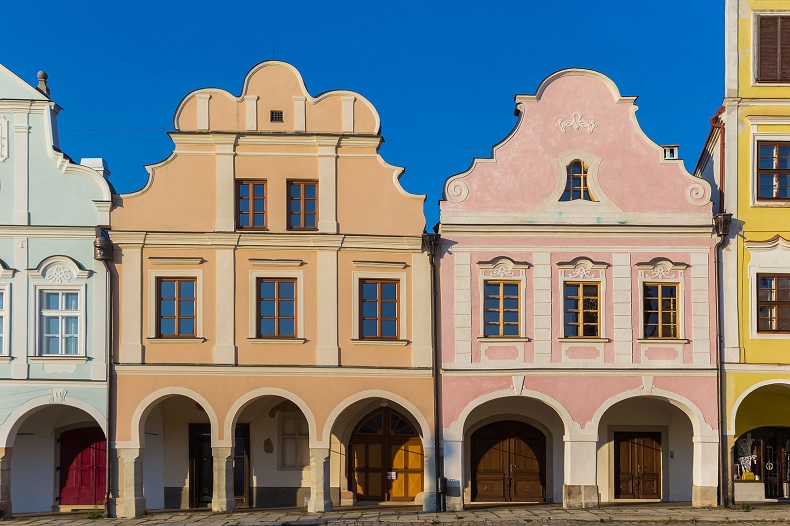Get to Know the Twelve Czech UNESCO Sites

Telc © venemama / Bigstock.com
If
anyone wanted to explore all the places inscribed on the UNESCO World
Heritage Site List, he would have to visit more than a thousand
destinations and the journey would take him several years. The Czech
Republic is unique with the number of sites one can visit by embarking
just on short trips. They offer a cross-section of European
history from the Romanesque era to the 20th centuryCzech Towns – Four UNESCO Gems
The best known, most popular and also the largest of the Czech monuments with the UNESCO stamp on them are the historical centres of four towns: Prague, Český Krumlov, Kutná Hora and Telč. They offer charming strolls across all architectural styles of Central Europe. Let yourself be enchanted by Prague Castle with St. Vitus Cathedral, Old Town with its Old Town Square and the former Jewish ghetto with a number of synagogues as well as unique Baroque monuments headed by the Church of St. Nicholas in Lesser Town. Unforgettable magic is emitted by the winding lanes and romantic nooks and crannies of Český Krumlov, as well as by its castle and chateau with a spectacular Baroque theatre. Kutná Hora attracts visitors not only to explore the historical centre of the town with the Gothic Church of St. Barbara, but also to the Sedlec quarter and its Cathedral of the Assumption of Our Lady. Its Baroque makeover was participated in by the noted architect Jan Blažej Santini in the early 18th century. And finally, referred to as a Renaissance gem among Czech towns, Telč is absolutely unique as it has been preserved as a compact medieval town with a water based defence system, chateau and a square, surrounded by picturesque houses with Renaissance and Baroque gables. If you have never been in a fairy tale, you will definitely feel as if you are in one here.
Second rendezvous with Santini
Situated less than 100 km away from Kutná Hora in the southeast direction, the pilgrimage Church of St. John of Nepomuk on Zelená hora towers over the town of Žďár nad Sázavou. Following the initiative of the Abbot of the local Cistercian monastery, the church was built by the architect Jan Blažej Santini in his peculiar Baroque Gothic style in the early 18th century. Similarly, as with other buildings of his, symbolism plays a great part here – take for example the pentagonal floor plan, five exits and five stars as well as five angels on the high altar. Will you try to uncover other secrets this masterpiece is shrouded in?
UNESCO in the countryside
In South Moravia you will discover the Lednice-Valtice Complex, regarded as the largest man made landscape in Europe. The Baroque and neo-Gothic architecture of the two chateaux is combined with small structures in the romantic spirit dotted around extensive forests and parks, maintained following the principles of English landscaping. If you are more into rural architecture, you definitely must pay a visit to Holašovice, a traditional village with several dozen houses built in the original style of South Bohemian folk Baroque and dating back to the 18th and 19thcentury. In a flurry of excitement and experiences evoked by other places, the village might seem to you quite ordinary, but believe it or not, you won’t find anything like it among UNESCO sites in the whole world.
On the trail of Jewish sites to Třebíč
The set of monuments in Třebíč includes the Romanesque-Gothic St. Procopius Basilica and the Zámostí Jewish Quarter , which after Jerusalem is the only Jewish site inscribed separately on the UNESCO list. Both of the sites manifest the long-term peaceful coexistence of the two cultures in a small Moravian town. The Jewish Quarter will enchant you with the mysterious atmosphere of the narrow winding alleys, dark corners and vaulted passages, where more than a hundred houses, including two synagogues and the former Town Hall, have survived to these days. Other places worthy of a visit are a couple of museums and galleries as well as the Jewish cemetery, ranking among the largest and best maintained cemeteries in the Czech Republic.
Renaissance and Baroque in chateaux and towns
There are more remarkable sites boasting UNESCO recognition to be found close by, such as the Renaissance Chateau in Litomyšl with wonderful sgraffito decoration of facades and gables, and the Archbishop's Chateau and gardens in Kroměříž. The Chateau Garden directly adjoins the chateau grounds, slightly to the side lies the extraordinary Renaissance Flower Garden with mazes, gazebos, fountains, pools, a greenhouse, colonnade and endless green walls made up of precisely trimmed trees and shrubs.
One of the smallest of the UNESCO sites is the Baroque Holy Trinity Column in the centre of Olomouc, but only in the terms of its ground plan. Actually, this thirty-five metre high column represents the largest grouping of Baroque statues in one sculpture in Central Europe.
Functionalistic miracle in Brno
An exceptional spectacle is also promised by the Villa Tugendhat in Brno, the most important European structure of the architect Ludwig Mies van der Rohe and the only gem of modern architecture in the Czech Republic to be included in the UNESCO World Heritage list. Built in 1929-1930 for Mr. and Mrs. Tugendhat, the Villa Tugendhat is traditionally ranked among the four houses in the world that most fundamentally influenced modern architecture. The other three are the Robbie House in Chicago designed by Frank Lloyd Wright, Steiner House in Vienna by Adolf Loos and the Villa Savoy in Poissy by Le Corbusier